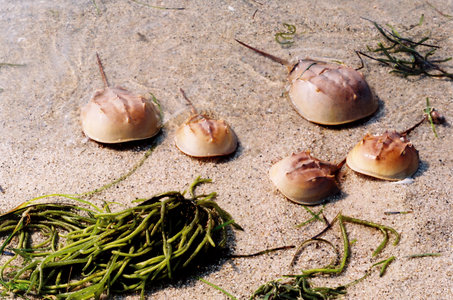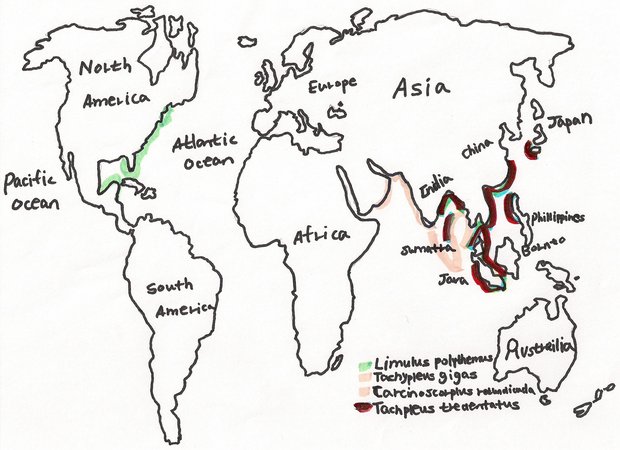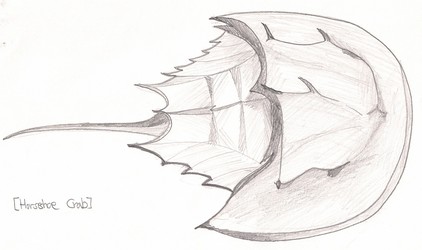

Atlantic horseshoe crabs, Limulus polyphemus. © 2006 Christian et Cie
Introduction
Horseshoe crabs are taxonomically distributed in four families around the world. They are divided into the Western horseshoe crabs, Limulus polyphemus, and the Eastern horseshoe crabs, Tachypleus tridentatus, Tachypleus gigas, and Carcinoscorpius rotundicauda. Limulus polyphemus lives along the Gulf of Mexico and the Atlantic Ocean, and the Eastern horseshoe crabs are widely distributed along the coast of Japan, the Philippines, China, Java, Sumatra and India. Horseshoe crab populations are distributed only in North America, Central America, and South East Asia.


Distribution of horseshoe crabs throughout the Earth. Map after Horseshoe Crab History Past and Present
Physical Characteristics
Limulus polyphemus is a chelicerate arthropod. It is more closely related to spiders, ticks and scorpions than to crabs. Unlike any other arthropods, it is jawless. It has five pairs of legs and two eyes on its shell. It can grow up to 60 cm long, and the female horseshoe crab is typically 25% to 30% bigger than the male horseshoe crab. It feeds on clams, worms and other invertebrates. The first four of the five pairs of legs are used for walking, while the last pair, located near the gills, has leaf-like flaps that are used for pushing. Males can be distinguished by the first pair of legs which are heavier than those of the female. Horseshoe crabs do not necessarily need to have their own homes because they can live in their shells anywhere they want.


Above view of Limulus polyphemus. Drawing by John Kauffman.
Reproductive Characteristics of the Life Cycle
The horseshoe crab reaches sexual maturity at 8-9 years for males and 10-11 years for females. The mating season is determined by light sensors on the body of the horseshoe crab which detect a change in hours of light per day. The peak of the mating season is synchronized with the moon cycles of late May and early June. The horseshoe crabs move from deeper waters to the edge of the beaches at this time to find mates. The males arrive several weeks earlier and scan the beaches for females. When the females arrive, they release a chemical which attracts the males and stimulates a sexual response. When the male finds its mate it uses its front set of claw like legs to attach itself to the female, who then drags them both onto shore. The female digs a nest in the sand. This is to prevent waves or predators from disrupting the hatching process. She will place around 5 to 7 clusters of several thousand eggs. With one mate she may lay around 20,000 eggs. This process is repeated multiple times in a spawning season. She may lay as many as 90,000 eggs in a year. An average egg takes 14 days from conception to birth.
Classification
- Kingdom - Animalia
- Phylum - Arthropoda
- Subphylum - Chelicerata
- Class - Merostomata
- Order - Xiphosura
- Family - Limulidae
- Genus - Limulus
- Species - Limulus polyphemus
Importance to the Ecosystem
Species that feed off the eggs of horseshoe crabs include the Semipalmated Sandpiper, the Red Knot, the Semipalmated Plover, the Least Sandpiper, the Pectoral Sandpiper, the Black-bellied Plover, the Ruddy Turnstone, the Sanderling and the Dowitcher. Sea Turtles and Finfish also feed on the nutritious eggs of the horseshoe crab. Aging horseshoe crabs generally host other organisms on their exterior or interior. These species include sea strawberries, blue mussels, sponges, oysters, scale worms, barnacles and tube worms amongst many others. Offering a rich environment for these species, the horseshoe crab is in turn maintaining a balance of the predators to these animals.
Status: Endangered or Healthy Population
This species has suffered a steady loss of habitat over the last 20 years and has declined in population. They are not considered endangered however. Estimates place the population on the north east coast of North America anywhere between 2.3 and 4.5 million.
Information on the Internet
- Asateague Island
- Horseshoe Crab University of Delaware College of Marine and Earth Studies
- The Horseshoe Crab
- Horseshoe Crab Reproduction
- Horseshoe Crab History Past and Present



 Go to quick links
Go to quick search
Go to navigation for this section of the ToL site
Go to detailed links for the ToL site
Go to quick links
Go to quick search
Go to navigation for this section of the ToL site
Go to detailed links for the ToL site